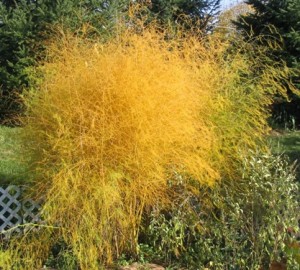Delicious, Delectable Asparagus
Delicious, Delectable Asparagus
If you are like me, asparagus is one of your favorite vegetables, and good for you, too. The great news is that asparagus is one of the easiest of all vegetables to grow in the home garden. The down side is it takes a few years to get a patch established, but the upside is that once you do you will have delicious asparagus to harvest for years, even decades, to come with very little effort on your part.
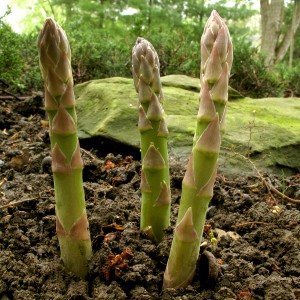 Asparagus is a perennial vegetable that can thrive for 15 years or more. Several varieties are available but the Jersey Male Hybrids have been shown to substantially outperform the older open pollinated varieties such as Mary Washington. Proper care is essential; a lack of care will result in a poor stand and a low yield. Following are recommendations for planting and care of asparagus in the home garden.
Asparagus is a perennial vegetable that can thrive for 15 years or more. Several varieties are available but the Jersey Male Hybrids have been shown to substantially outperform the older open pollinated varieties such as Mary Washington. Proper care is essential; a lack of care will result in a poor stand and a low yield. Following are recommendations for planting and care of asparagus in the home garden.
Soil and Fertilization – Asparagus has an extensive root system (each square in the diagram of a six year old plant below is 1 foot square). It is most productive on deep, well-drained sandy loam soils, but will do well on other soils if it has good drainage. Asparagus plants lose vigor, become more susceptible to root rot, and die in poorly drained areas. It grows best when the pH is between 6.7 and 7.0. Prepare your soil by applying 1 to 2 inches of T&C Soil Enhancer or compost, 1/2 cup superphosphate (0-20-0) per 10 sq. ft., and 1/4 cup soil sulfur per 10 sq. ft. Then work the soil 8 to 12 inches deep.
Planting Crowns – It is important that you soak the roots in a bucket of water and root stimulator for 1 to 6 hours, just before planting. Even roots that appear dry and shriveled will usually perform well if they are soaked before planting. The Jersey Male Hybrids have been found to perform best when planted 6 inches deep. Apply superphosphate (0-20-0) in the bottom of the trench at a rate of 1/4 cup per 10 sq. ft. (This is in addition to the phosphorus that was applied earlier.) Research has shown that the crowns will grow more vigorously when 0-20-0 is used. It will not burn the crowns.
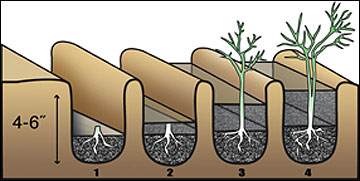 Place the crowns in the trench (1). The buds should face up, although it’s not critical. They can even be lying on their sides, just be sure that none of the roots are crossing or tangled. Distance between crowns (bud to bud) is determined by the spear diameter required. A thick spear (½ inch – ¾ inch) is obtained by planting the crowns 12” apart. A thinner spear (3/8 inch – 5/8 inch) is obtained by planting 8” apart.
Place the crowns in the trench (1). The buds should face up, although it’s not critical. They can even be lying on their sides, just be sure that none of the roots are crossing or tangled. Distance between crowns (bud to bud) is determined by the spear diameter required. A thick spear (½ inch – ¾ inch) is obtained by planting the crowns 12” apart. A thinner spear (3/8 inch – 5/8 inch) is obtained by planting 8” apart.
Once the crowns are placed in the trench, cover them with 1 to 2 inches of soil (2). Cover as soon as possible to prevent any sun damage to the crowns. We recommend planting no closer than 4½ feet between rows. Jersey male varieties are very vigorous in their growth. If planted too close together, their ferns will become very dense and restrict air circulation. This creates a stagnant atmosphere where diseases can easily take hold and flourish.
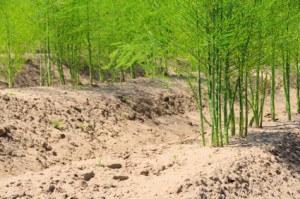 Care After Planting – As the asparagus grows, gradually fill in the trench with soil, being careful to avoid covering any asparagus foliage. The trench should be filled to ground level by the end of the first growing season.
Care After Planting – As the asparagus grows, gradually fill in the trench with soil, being careful to avoid covering any asparagus foliage. The trench should be filled to ground level by the end of the first growing season.
Side dress with T&C Fruit & Flower Food (10-20-10) fertilizer in late July or early August at the recommended rate.
Adequate soil moisture is important during the first growing season. Weekly applications of irrigation sufficient to wet the soil 8 inches deep should be adequate. After the first growing season, asparagus plants do not require frequent irrigation because of their deep and extensive root system. Thorough watering (2-3 inches of water) slowly applied every two weeks during dry weather is sufficient.
Late in the fall, after the fern has turned completely brown, remove the brush (old stalks) and any weeds. Broadcast soil sulfur in the fall or early the following spring as needed to maintain the proper soil pH. Feed at half rate with T&C Fruit & Flower Food in early spring and again when harvesting is completed. This will help speed the development of the fern so the photosynthesis process can begin.
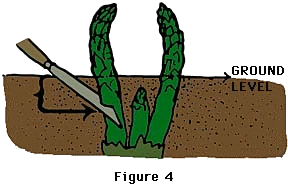 Harvesting – Begin harvesting two to three years after planting. For cutting, use an asparagus knife. Cut the spear off about one inch below the soil line. (Fig. 4) Use caution not to cut too deep, as you may damage the asparagus crown. We advise adding a 4-inch ridge of soil once the spears begin to emerge – this will help prevent crown damage by cutting too deep.
Harvesting – Begin harvesting two to three years after planting. For cutting, use an asparagus knife. Cut the spear off about one inch below the soil line. (Fig. 4) Use caution not to cut too deep, as you may damage the asparagus crown. We advise adding a 4-inch ridge of soil once the spears begin to emerge – this will help prevent crown damage by cutting too deep.
Harvest the spears when they are between 7-10 inches long. Harvest all spears that come up during the harvest season.
There you go. It’s easier than it may seem. Just follow the tips above, wait a couple of years, and begin enjoying bountiful harvests of delicious, delectable asparagus.



